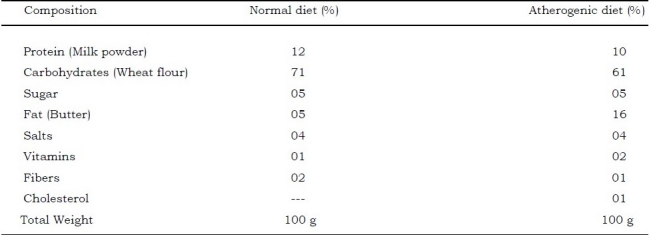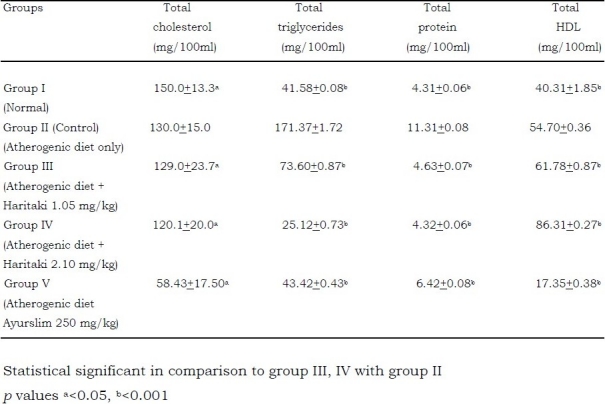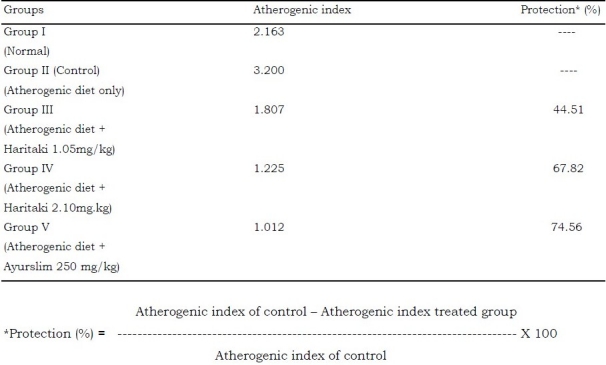Abstract
Haritaki (Terminalia chebula) family Combretaceae is an important plant used traditionally for medicinal purposes. It is component of the classic Ayurvedic combination called “Triphala”. Hyperlipidemia was induced by treated orally with atherogemc diet. In atherogenic diet induced hyperlipidemic model, the rats receiving treatment with Haritaki showed significant reduction in total cholesterol, triglycerides, total protein and elevation of high density lipoprotein cholesterol. Haritaki was found to possess significant hypolipidemic activity. The results also suggest that Haritaki at 1.05 and 2.10 mg/kg b.wt. concentrations are an excellent lipid-lowering agent.
Keywords: Cholesterol, Haritaki, Hyperlipidemic, Triglyceride
INTRODUCTION
Haritaki consists of dried pericarp of mature fruits of Terminalia chebula belonging to family Combretaceae. It is moderate to large sized tree found throughout India, chiefly in deciduous forests and areas with light rain fall, but occasionally found in moist forest up to an altitude of 1500 m. It is a moderate sized to a large deciduous tree attaining a height of 25-30 m. with a cylindrical bole, rounded and spreading branches. Leaf buds, branches and youngest leaves are covered with soft, shining rust coloured hairs[1,2]. The fruits ripen from November to March, depending upon the locality, and fall soon after ripening. The dried fruits constitute one of the most important vegetable tanning materials and have been used in India for a long time. The mature fruits are collected during January April by shaking the trees, and are then dried in thin layers, preferably in shade, and graded for marketing[3]. The fruit contains ellagic acid, gallic acid, chebulinic acid, chebugalic acid and corilagin. The herb is used as tonic and deobstruent in hepatic and spleen enlargements and in skin diseases in Ayurvedic system of medicine[4]. The present study has been undertaken to establish the hypolipidemic effect of Haritaki (Terminalia chebula) on normal and atherogenic diet induced hyperlipidemia in rats.
MATERIALS AND METHODS
Chemicals
Haritaki (Terminalia chebula) and Ayurslim herbal drug used in this study was obtained from the Himalaya Drug Company, Bangalore, India. Diagnostic kits for estimation of cholesterol (Merck), Triglyceride (Merck) and High density lipoprotein (CDR Diagnostic) were purchased from Modern Scientific Company, Coimbatore, India. Atherogenic diet was purchased from local market.
Drug preparation
Haritaki (Terminalia chebula) (1.05 and 2.10 mg/ kg body weight) and Ayurslim (Dose 250 mg/kg body weight) was dissolved in 9 ml saline. The suspension was given orally with the help of baby feeding tube to albino rats.
Animals
Male healthy adult Wistar rats (150-170 g, age 90 days) were obtained from M/ s. Dr. Samsun Immuno Research Laboratory, Tirupur (TN), India. They were housed in plastic cages with filter tops under controlled conditions of a 12 h light/ 12 h dark cycle, 50% humidity and 28°C. The animals were fed standard rats chow (Lipton Lever Ltd., India) and water ad libitum. The animal experiments were approved by animal ethical committee of institute (722/02/a/CFCSEA dt. 04.12.2006). The composition of atherogenic diet used during the study was given in Table 1.
Table 1.
Composition of normal and atherogenic diet

Induction of hyperlipidemia
In order to induce hyperlipidemia, the method reported by Bopanna et al.[5] was followed. The animals were divided into 5 groups of 6 rats each and they received the following with or without treatment for 14 days orally.
Experimental design
Animals were divided into different groups with six animals in each group. Group I served as normal control and received standard diet throughout experimental period. Group II, III and IV received atherogenic diet throughout the treatment period. Group III and IV received Haritaki (Terminalia chebula) (1.05 and 2.10 mg/ kg body weight). Group V received Ayurslim (250 mg/kg body weight). Treatment periods for all these groups were 14 days.
At the end of treatment period to all these groups, the animals were used for various biochemical parameters. The animals were deprived of food overnight, anesthetized using light ether and sacrificed by cervical decapitation. Blood was collected and centrifuged by using table top centrifuge at 2000 rpm for 30 minute so at to get serum.
Measurement of serum lipid profile
Total cholesterol (TC), total triglycerides (TG), total protein (TP) were estimated by the method of CHOD-PAP using standard kits and total high density lipoprotein (HDL) were estimated by the method of GPO-PAP using standard kits. The atherogenic index was calculated by using the following formula.

Statistical analysis
Statistical analysis was carried out by Student's t-test[6].
RESULTS
The results reveal that feeding of atherogenic diet increased serum total cholesterol, triglyceride and total protein and decreased serum HDL-cholesterol levels when compared to normal group at over a period of 14 days. Administration of 1.5, 2.1 mg/kg per day of Haritaki (Termznalia chebula) and 250 mg/kg per day of Ayurslim showed statistically significant decreased in total cholesterol (p<0.05), triglyceride (p<0.001) and total protein (p<0.001) level as compared to hyperlipidemic animals (Table 1). At this time an increase of HDL-cholesterol level was also observed. Both 1.5 and 2.1 mg/kg body wt. Haritaki treated animals and 250 mg/ kg body wt of Ayurslim treated animals showed decrease in the atherogenic index and increased percentage of protection (Table 2).
Table 2.
Effect of treatment for 14 days with Haritaki on plasma lipid profile of normal and atherogenic diet induced by hyperlipidemic rats

DISCUSSION
Treatment with Haritaki (Terminalia chebula) produced a significant decrease in the serum level of lipids in atherogenic diet induced hyperlipidemia in rats. Atherogenic diet induced hyperlipidemic model has been successfully employed for the evaluation of Hypocholesterolemic effect of protein[7,8] and S-allyl cystein sulphoxide of Allium sativum[9] in albino rats. Ahluwlaia and Amma[10] found that feeding of oleoresin of gum guggal (Comrniphora mukul) lowered the total cholesterol and its fractions in lipoproteins. Reshma et al.[11] have reported hypolipidemic activity of the chebulinic acid and corilagin from Haritaki. Cell culture derived from Hemidesmus indicus contain high amount of phytosterols. Beta sitosterol, a phytosterols is reported as useful in the treatment of hyperlipidemia[5]. Sudheesh et al.[12] reported that condensed tannins of Solanum melongena are reduced in hyperlipidemia and hyperglycemia. Hypolipidemic effect of proteins, gums, saponins and beta sitosterol have been reported by several authors. Haritaki contains alkaloids phytosterols, saponins, tannins, ellagic acid, gallic acid, chebulinic acid, chebugalic acid and corilagin. High amount of saponins, phytosterols, chebulinic acid and corilagin present in Haritaki may be responsible for the hypolipidemic effect[13].
Faulty diet is a very common cause of heart disease. Particularly, with an increase in inclination towards fast foods, which are rich in saturated fats, an increase in coronary heart disorder (CHD) is being observed in the developing countries since past few decades[14]. A 1% decrease in HDL-cholesterol is associated with a 3-4% increase in the risk of heart disease. For male and female, concentration of HDL-cholesterol below 1.0 and 1.2 mmol/L (39, 46 mg/dl) and especially below 0.8 and 1.0 and 1.2 mmol/L (31, 39 mg/ dl) confer an increased risk of CHD, whereas concentration exceeding 1.5 and 1.7 mmol/L (58, 66 mg/dl) diminishes the influence of other risk factors[15].
In the present study an increase in plasma HDL-cholesterol with a concomitant percentage decrease from other lipid was observed (Table 2 and 3). It can be concluded from the present data that the levels of total serum cholesterol, triglyceride and total protein with are actually raised in atherogenic diet, can be lowered significantly with Haritaki (Terminalia chebula) . Haritaki (Terminalia chebula) can be utilized for providing dietary management in the prevention of atherosclerosis in hyperlipidemic patients.
Table 3.
Atherogenic index in various groups

REFERENCES
- 1.Aiyer K.N., Kolammal M. Dept. of Pharmacognosy. 7. Vol. 1. Trivandrum: University of Kerala; 1963. Pharmacognosy of Ayurvedic drugs; pp. 102–105. [Google Scholar]
- 2.Padhi M.M. Medicinal plants in geriatric health care, CCRIAS. Dept. of AYUSH, Min. of Health & Family Welfare, Govt. of India. 2008:39–42. [Google Scholar]
- 3.Krishnan K. The Wealth of India, Raw Material. 1998;10:171. [Google Scholar]
- 4.Chopra R.N., Nayar S.L., Chopra I.C. New Delhi, India: CSIR; 1956. Glossary of Indian Medicinal Plants; p. 104. [Google Scholar]
- 5.Bopanna K.N., Bhagyalakshmi N., Rathod S.P., Balaraman R., Kannan J. Cell culture derived Hemidesmus indicus in the prevention of hypercholesterolemia in normal and hyperlipidemic rats. India J. Pharmacol. 1997;29:105. [Google Scholar]
- 6.Bennet C.A., Franklin N.L. New York: John Wiley Sons; 1967. Statistical analysis in chemistry and chemical industry; p. 133. [Google Scholar]
- 7.Salil G., Rajmohan T. Hypolipidemic and antiperoxidative effect of coconut protein in hypercholesterolemic rats. Indian J. Exp. Biol. 2001;39:1028. [PubMed] [Google Scholar]
- 8.Dhandapani P. Hypolipidemic activity of Eclipta prostrate (L.) leaf extract in atherogenic diet induced hyperlipidemic rats. Indian J. Exp. Biol. 2007;45:617–619. [PubMed] [Google Scholar]
- 9.Sheela C.G., Augusti K.T. Antiperoxide effects of S-allyl cysteine sulphoxide isolated from Allium sativam Linn. and guglipid in cholesterol diet fed rats. Indian J. Exp. Biol. 1995;33:337. [PubMed] [Google Scholar]
- 10.Ahluwalia P., Amma M.K.P. Effect oral ingestion of oleoresin of gum-guggal on the fecal excretion of cholesterol and bile acids in hypo and hypercholesterolemic rats. Res. Bull. Punjab Univ. 1998;39:53. [Google Scholar]
- 11.Reshma S., Parab, Sushmn A., Mengi Hypolipidemic activity of Acorius calamus Linn. in rats. Fitoterapia. 2002;73:451. doi: 10.1016/s0367-326x(02)00174-0. [DOI] [PubMed] [Google Scholar]
- 12.Sudheesh S., Vijay Kumar S., Sandhya C., Vijayalakshmi N.R. Toxic effects of condensed tannins from Solanum melongena on rats. J. Ecotoxicol. Enviromen. Monit. 1996;6:221. [Google Scholar]
- 13.Gupta A., Mishra A.K., Bansal P., Singh R., Kumar S., Gupta V. Phytochemistry and Pharmacological activities of Haritaki – A review. J. Pharm. Res. 2010;3(2):417–424. [Google Scholar]
- 14.Kulkarni S.K., Kaur Gurpreer. Obesity: an insight into its neurochemical basis and treatment. Indian J. Pharmaco. 1999;31:388. [Google Scholar]
- 15.Ahirwar A., Singhai A.K., Dixit V.K. Effect of Terminalia chebula fruits on lipid profiles of rats. J. Natural Remedies. 2003;3:31. [Google Scholar]


